Tom's Guide Verdict
The LG C9 OLED blows us away with impressive picture and sound, a truly smart smart TV experience, and a decidedly sleek design.
Pros
- +
Impeccable OLED display
- +
Cutting-edge HDMI 2.1 connectivity
- +
Best-in-class performance
- +
Great sound
- +
Solid smart-TV features
- +
Google Assistant and Amazon Alexa built in
Cons
- -
Premium price will turn many away
Why you can trust Tom's Guide
When it comes to premium TV technologies, one in particular stands out, thanks to its precision lighting and superslim design: OLED. And the LG C9 OLED ($2,199 for the 65-inch model, $4,499 for the larger 77-inch) has been on our radar for months as LG has given us glimpses and bits of information. Now, we've finally gotten the C9 OLED into our lab for testing, and everything we'd suspected was true: The LG C9 OLED offers an unparalleled blend of superb media performance, rich features and forward-looking technologies. It's the best TV we've seen, and our top pick as the best TV overall.
Editor's Note (8/10/2020): We've updated this review with current pricing and availability information, but the rating remains unchanged. Check out our LG CX OLED review for the latest model. Learn more about the latest LG models in our roundup of all the LG 2020 TVs.
LG C9 OLED (OLED65C9PUA) Specs
| Price | $2,496.99/£2,099 |
| Screen Size | 65 inches |
| Resolution | 3,840 x 2,160 |
| HDR | Dolby Vision, HDR10, HLG |
| Refresh Rate | 120 Hz |
| Ports | 4 HDMI 2.1, 3 USB |
| Audio | 2.2 channels, 2 x 40-W speakers w/20-W woofer |
| Smart TV Software | webOS 4.0 |
| Size | 57 x 32.7 x 1.8 inches [w/o stand] |
| Weight | 55.6 pounds [w/o stand] |
LG C9 OLED review: Price and availability
The C9 OLED comes in three sizes, starting at 55 inches and scaling up to 77 inches. Our own review unit sits right between the two, at 65 inches.
- 55 inches: OLED55C9PUA (no longer available)
- 65 inches: OLED65C9PUA ($2,199.99)
- 77 inches: OLED77C9PUB ($4,496.99)
Because OLED technology offers remarkably consistent picture quality, we feel very comfortable saying that our performance test results are likely indicative of similar quality in the models of other sizes. And because all three models feature the same processing hardware and smart TV features, we're confident in extending our recommendations to these other sizes.
LG C9 OLED review: Design
LG's OLED TVs consistently offer some of the best designs in the world. The company leverages the unique properties of OLED technology to make a remarkably thin and elegant display that strips the panel down to the essentials of a glass panel and a layer of printed OLED pixels, backed with a gleaming layer of brushed aluminum, with a gunmetal finish that oozes style.
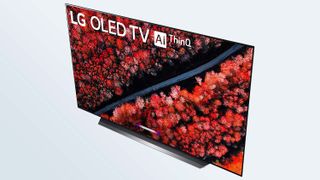
"The top half of the TV is an impressive 0.1 inches thick. This is the sort of slimness that makes you stop and stare, even if you've looked at dozens of premium TV designs."
Without the stand, the LG C9 measures 57 x 32.7 x 1.8 inches. Most of the thickness is at the bottom of the TV, which is less than 2 inches thick overall and houses the set's internal components and speakers. The top half of the TV, however, is an impressive 0.1 inches thick. This is the sort of slimness that makes you stop and stare, even if you've looked at dozens of premium TV designs. The only things to surpass it are LG's own Wallpaper and Rollable designs, which push the display-on-glass concept to even more innovative ends.
By comparison, the LCD-based Samsung Q90 measures 57.1 x 32.7 x 1.6 inches, with a fairly consistent thickness from top to bottom. That design offloads most of those same components to reduce the TV's thickness.
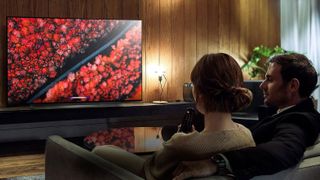
The C9 sits lower than most sets, thanks to a low-slung stand design. The brushed-metal stand looks just as elegant as the rest of the TV and provides a slight contrast with the darker finish of the TV cabinet.
The included stand offers a very solid footing for the slim TV, and well it should, weighing nearly 20 pounds by itself. The stand uses a single wide, flat foot centered in the middle of the screen. This stand also extends back several inches, providing a wide base that manages to be unobtrusive as it anchors the 65-inch TV. You can use a channel in the stand to tuck cables out of sight and keep the unsightly snarl to a minimum.
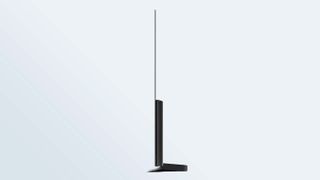
The TV itself weighs 55.6 pounds without the stand — the TV can be hung on the wall with a 300 x 200-millimeter VESA mount — and 74.7 pounds with the stand attached. The base attaches easily with a screwdriver, but you'll want to make sure that the TV is laid flat on a safe surface where you can place the stand. You'll also want a second person to help lift the TV, since the 75-pound set is mostly glass, with only minimal housing to protect it from flexing and potentially cracking.
LG C9 OLED review: Ports
While the outward design of the C9 offers only minor refinements over previous models, the port selection presents a major upgrade. All of the basic connections are present: three USB ports, an RF connector and tuner for antenna, composite input for older hardware, and an optical output for older audio systems.
But the real star here comes in the four HDMI ports; they all use HDMI 2.1, which you'll find only on LG's 2019 models. The new standard will support 4K at 120 Hz, provide a fatter pipe for dynamic HDR information, and handle uncompressed audio for soundbars and surround-sound systems using Enhanced Audio Return Channel (eARC), the new and improved version of the return-channel technology that lets you reduce cable clutter by running a single cable between the TV and soundbar.
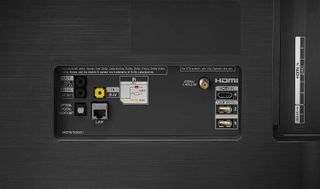
The new connection standard also supports Quick Media Switching (QMS), which adjusts the TV's resolution and frame rate to match whatever content you're putting on screen. If you've ever tried to play a 24-Hz movie on a 60-Hz panel, you may have noticed the display goes black as you move from one content mode to another. QMS eliminates this buffering step, making it all the more seamless to enjoy all media sources on your TV.
Those HDMI 2.1 connections also promise enhancement for gaming, with an automatic low-latency mode (ALLM), which switches to game mode when it senses that a game console is connected and active. There's also variable refresh rate (VRR) support, which lets gaming hardware cut loose while maintaining buttery-smooth action and eliminating dropped frames with a technology similar to AMD's FreeSync.
The Xbox One X has VRR capability already, but only up to 60 frames per second. However, thanks to the wider bandwidth of HDMI 2.1, this technology will scale up to 120 Hz on future game consoles (such as the Sony PS5 and Xbox Project Scarlett) and graphics cards. That makes the LG C9 OLED distinctly future proof.
The C9 OLED also gets some advanced wireless connectivity. In addition to 802.11ac Wi-Fi (along with an Ethernet jack for wired networking) and Bluetooth 5.0, the C9 is also ready to go with new wireless options. The C9 is WiSA-ready, so you can connect to wireless sound systems that use the WiSA standard. That's a huge bonus for anyone who wants to set up a surround-sound system without running wires around the room or in the walls.
The C9 also supports Apple AirPlay 2, so it's easy to wirelessly share content from your iPhone (or iPad, or iPod, or MacBook) to the TV and use the set for controlling your smart home devices via Apple's HomeKit.
LG C9 OLED review: Performance
The LG C9 has a 65-inch OLED panel that looks stunning, thanks to excellent color quality, impressive brightness and extremely smooth action. It's one of the best displays we've seen, in large part because it's almost identical to last year's OLED panels.
LG has set a high bar for OLED quality, to the point that the C9 (and other 2019 OLEDs) don't actually offer significant improvements to the display panel over anything we saw last year. The panel technology remains unchanged, because the technology has been pushed just about as far as it will go. The 2019 panels get a little brighter than older versions, but otherwise, they offer the same performance and quality as seen in previous models. That's not a problem, because the level of quality is impeccable.
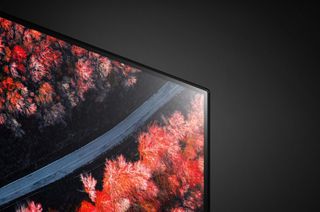
"The overall quality is superb, with rich, inky blacks, vibrant colors and perhaps the best HDR experience you'll get from a 4K TV."
And the display is only half of the equation. LG's Alpha 9 Gen 2 processor does more than just handle new smart-TV features. It also enhances the picture quality through improved noise reduction, superb upscaling and AI-powered brightness control that keeps the display looking the same under changing lighting conditions.
All of those incremental refinements add up to the best picture we've seen on any 4K TV in 2019. This panel even edges out the Sony Master Series A9F OLED from 2018, which had set the bar for premium picture quality. Whether it's showing a scene from Blade Runner 2049, a 4K stream of surf-survival thriller The Shallows or the 4K trailer for Top Gun: Maverick, the C9 looks fantastic.
The overall quality is superb, with rich, inky blacks; vibrant colors; and perhaps the best HDR experience you'll get from a 4K TV, with broad support for formats like HDR10, Dolby Vision and Hybrid Log-Gamma (HLG) for live content.
One of our standard test scenes from Blade Runner 2049 takes place inside a farmhouse, with most of the light for the scene pouring in from exterior windows. Where most LCD-based TVs struggle to show this lighting without over-illuminating other parts of the picture, the C9 OLED's per-pixel lighting means there is zero haloing. And while other premium sets lose some detail in the darker shadows of the scene, or simply lose the shadows as the brightness bumps up to compensate, the C9 struck the perfect balance, with crisp details and appropriate lighting.
Viewing angles are also the best we've seen, maintaining color consistently from the optimal dead-center viewing position out to nearly 180 degrees with no color shifting or negative effect. In fact, at the steepest angles, the larger problem was the reflectivity of the glass.
Two areas where even the best TVs struggle are in upscaling from lower-resolution content and in maintaining clarity when showing fast action. In both instances, it's not uncommon to see blurred movement, hazy details and digital artifacts. But the C9 managed to keep things clean and clear, whether it was a fight scene from Spider-Man: Homecoming or a 1080p scene from Mad Max: Fury Road.
LG C9 OLED review: Test Results
The C9 looks great, but sometimes manufacturers will give a TV display a tweak that makes it look good while actually making it slightly less accurate. The set may hew less true to the precise colors and lighting that a director intended, while the brightness or color saturation get ramped up to make images pop a little more on screen. These changes may even goose the numbers in testing, like the evaluations we perform as part of every review. Thankfully, LG's OLED displays not only look great, but they also offer solid accuracy and impressive technical capability.
With 10-bit color support, the C9 offers a wider color pallette than most 4K TVs. When we tested the C9 with our X-Rite i1 Pro spectrophotometer and SpectraCal CalMAN Ultimate calibration software, the display was able to reproduce 132.14% of the Rec 709 color space, exceeding the basic standard with a wider selection of colors. This is slightly better than the Sony Master Series A9F (130.83%) and way better than even premium LCD TVs, like the Sony X950G (99.87%) and the Samsung Q90 QLED (99.83%).
This broader selection of colors made for great results in 4K movies, like Blade Runner 2049, where billowing fog banks looked highly realistic and glowing neon cast multicolored lights across people and buildings. Even elements that other TVs struggle with, like a foggy scene that usually suffers from posterization even on premium TVs, the C9 showed smooth color transitions and ultrarealistic hues.
The C9 OLED is also one of the most accurate TVs we've tested. Accuracy is measured using a Delta-E rating, which is the deviation between how color is supposed to look and what actually shows up on screen. A smaller score is better (0 is perfect), and the C9 OLED scored a respectable 1.88 in the most accurate mode, which LG calls ISF Expert (Dark Room). It's a tad more precise than the standard picture mode result of 2.15, but even that's impressively accurate for a consumer-level display.
While that's not the platonic ideal, it's better than we've seen on other top performers, like the Sony A9F (3.5), the Sony X950G (2.56) and the budget-friendly Vizio M-Series Quantum (3.6). The only recent set to do better is the Samsung Q90 QLED (1.5), but the visible results are extremely similar.
LG OLED vs. Samsung QLED
A comparison between the LG C9 OLED and the Samsung Q90 QLED highlights the strengths and weaknesses of the two different technologies. The LG C9 delivers the best black levels available, thanks to OLED technology's ability to illuminate the individual pixels that make up the picture. The result is crisp, clearly defined lighting, with inky blacks and zero haloing of bright objects on screen. Samsung's competing technology has gotten very, very good at delivering similar black levels, but put the two sets side by side, and the C9 OLED is the clear winner.
But it's a different story for overall brightness. OLED screens don't have the backlight illumination that an LCD panel uses, which limits the brightness to whatever the glowing pixels can produce. LG has made enormous strides on this front, but the Samsung has the edge here.
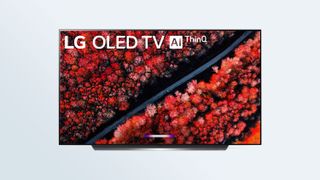
"The LG C9 provides the option of automatically switching the TV to game mode for lower latency, all without having to find the remote to change the picture setting."
That's not to say that the C9 appeared dim or failed to handle bright content well. In fact, HDR content looks better on the C9 OLED than on perhaps any other TV we've tested. What is meant to be black is black, but LG's image processing offers better subtle, near-black and dark tones than we've seen in years past. Older OLED TVs struggled with crushed blacks, an effect caused by the difficulty of displaying a dark tone without it simply looking black, but I didn't encounter this problem to any noticeable degree during testing.
LG C9 OLED review: Gaming performance
When we plugged in our Xbox One X to check out 4K gaming on the C9, we were pleasantly surprised to find something new. Not only did the TV support every feature available for 4K gaming and content — 10-bit color, all frame rates, HDR10 and Dolby Vision content, and HDR gaming — but it also offered us new capabilities. With advanced features enabled, the Xbox offered variable refresh rates.
The LG C9 also provided the option of automatically switching the TV to game mode for lower latency, all without having to find the remote to change the picture setting. The switch was automatic when the console was turned on. These additional features are a benefit of the TV's HDMI 2.1 ports, which have greater bandwidth than the HDMI 2.0 ports found on the majority of 4K TVs.
Actual gaming performance was pretty great. With a measured lag time of 21.2 milliseconds, this is the most responsive high-end TV we've seen. And thanks to the C9's awesome display, 4K gaming looks fantastic. Racing through Australia in Forza Horizon 3 was a rush of sun, sand and supercars. Exploring ancient Egypt was equally vibrant in Assassin's Creed: Origins.
LG C9 OLED review: Audio
The C9 packs a surprising amount of audio hardware into a slim chassis, especially since half of it is mostly glass. A pair of 40-watt speakers provide ample volume, with a downward-firing position in the bottom of the TV chassis. This machine also boasts a 20-watt woofer, which gives the bass a lot more oomph than you might expect from such a lithe design. Overall, the volume gets decently loud, and the bass levels are better than what most TVs offer.
However, reflecting sound off of whatever table or shelf is below the TV will lead to mixed results, since it won't be the same in our lab as in your home. We also noticed some slight distortion as the volume approached full blast. You can fix both of these issues by getting one of the best soundbars to go with the TV.
One more reason for a soundbar? Dolby Atmos support. The LG C9 can handle Dolby's vertical sound stage on the decoding side, but for the best performance, you want a speaker set or soundbar that can offer a fuller Atmos experience.
LG also offers a feature called AI Sound, among a number of other smart features. This automatic process uses the microphone in your remote to listen to the sound coming from the speakers and then adjusts the sound to provide a better listening experience. Since it lets the TV's machine-learning smarts adapt to the acoustics of the room the set is in, this feature can actually provide a significant improvement in overall sound quality, providing a uniquely tuned, simulated-5.1 sound experience tailored to your living room.
LG C9 OLED review: Smart features
We've already touched on the C9's potent Alpha 9 Gen 2 processor, but it really comes to the forefront with LG's webOS interface and ThinQ AI capabilities. And while the new webOS looks and feels a lot like the one we saw on LG's 2018 models, this version comes with several improvements.
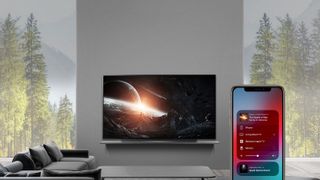
"This is the first smart TV we've seen that offers both Alexa and Google Assistant."
Most of the AI-stuff happens behind the scenes, with automatic features like brightness adjustment, tailored content recommendations and self-managed app organizing. But there are some more interactive capabilities under the ThinQ umbrella that are sure to spark some interest.
The first is the option to use either the default Google Assistant, which is tied to the remote microphone button and is integrated into the TV's functions, or Amazon Alexa, which has recently been added. The Amazon assistant is accessed by pressing and holding the Amazon Prime Video button. This the first smart TV we've seen to offer both leading voice assistants.
There's also a new tool for smart home devices, called Home Dashboard. Aimed at making the TV a central control hub for all of your connected home stuff — ranging from the best video doorbells to smart thermostats and online kitchen appliances — it looks to be a great option for any gadget lover. Home Dashboard also offers a strong alternative to SmartThings, which offers similar capability on Samsung TVs, especially for devices in that company's ecosystem.
LG C9 OLED review: Remote control
The LG Magic Motion remote control continues to be one of the best on the market, offering a comfortable device that's fairly easy to navigate, despite being loaded with buttons. The use of a clickable scroll wheel in conjunction with a standard directional pad makes navigating through smart TV menus a breeze. But the inclusion of a motion-controlled cursor, which means you can swoop around the screen with a waggle of the remote, gives this remote an advantage over the competition. Text entry is much easier and faster, and selecting items quickly from setting and app menus becomes less confusing and cumbersome when it's simply point and click.
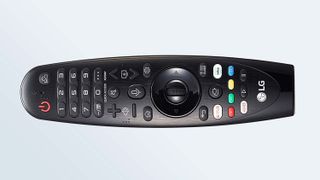
As mentioned earlier, the remote has voice interaction built in. And it can be used with both Google Assistant and Amazon Alexa, provided you have an Amazon account set up on the TV.
LG C9 OLED review: Verdict
There are no two ways about it — the LG C9 OLED is the best TV we've seen in 2019, and it gets our top recommendation for 4K smart TVs. The design is inspiring, the smart functions intelligent and approachable, and the performance superb. If you want the best 4K TV on the market, this is it.
If you want a similar OLED experience without the LG branding, the Sony Master Series A9F is a good choice for you, offering a level of picture quality very close to the C9's. The Sony also has slightly better audio, thanks to the company's sound-from-screen audio technology, and Android offers a robust smart-TV experience. The real problem with the Sony A9F isn't the TV or the software, but the price, which is about a third more than the LG C9's.
And if you aren't sold on the virtues of OLED and want to go with a premium LCD, the Samsung Q90 QLED ($2,499/£2,495) is a formidable option. The picture quality is very, very good, and the Samsung smart TV platform compares very well to LG's webOS. However, the LG C9 is still our top pick, thanks its category-leading performance, undeniable smarts and sharp, stylish design.
Brian Westover is currently Lead Analyst, PCs and Hardware at PCMag. Until recently, however, he was Senior Editor at Tom's Guide, where he led the site's TV coverage for several years, reviewing scores of sets and writing about everything from 8K to HDR to HDMI 2.1. He also put his computing knowledge to good use by reviewing many PCs and Mac devices, and also led our router and home networking coverage. Prior to joining Tom's Guide, he wrote for TopTenReviews and PCMag.


